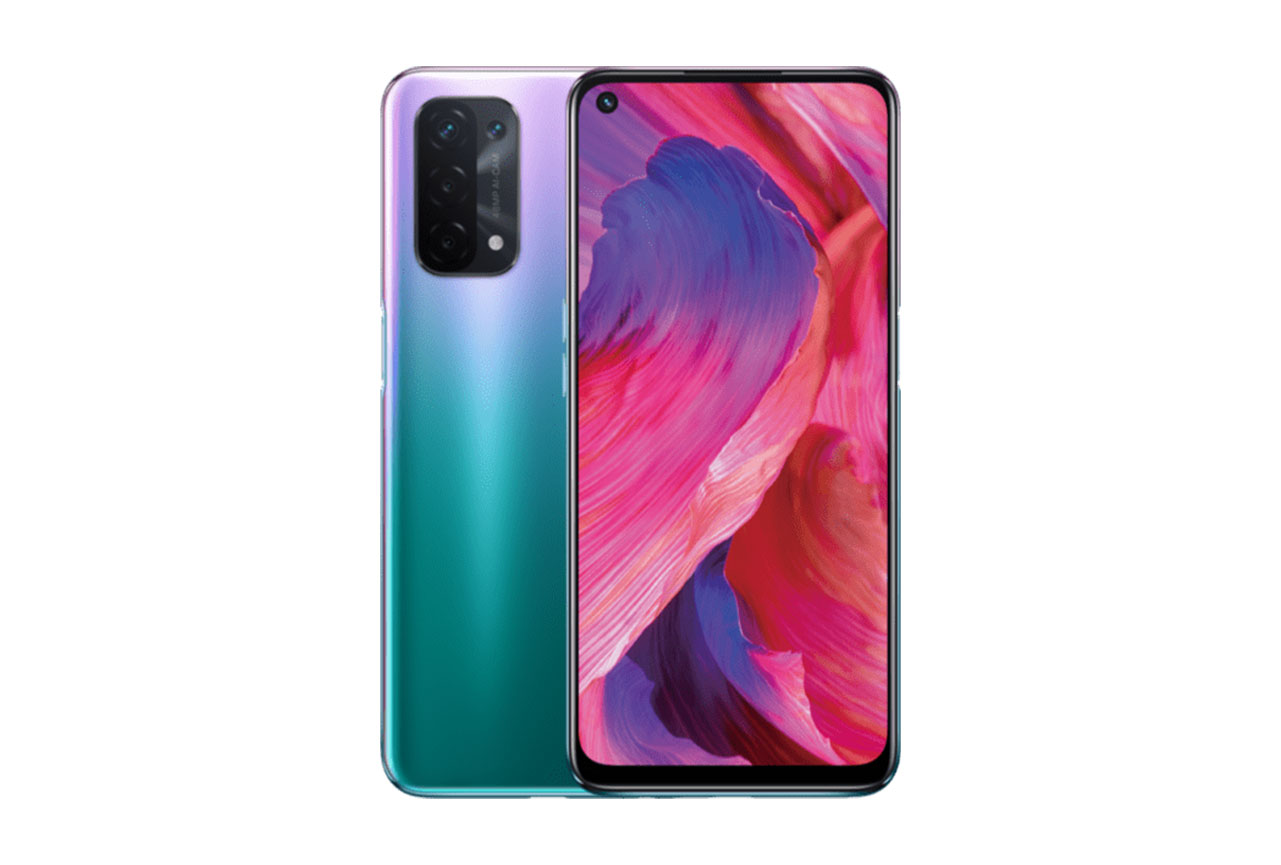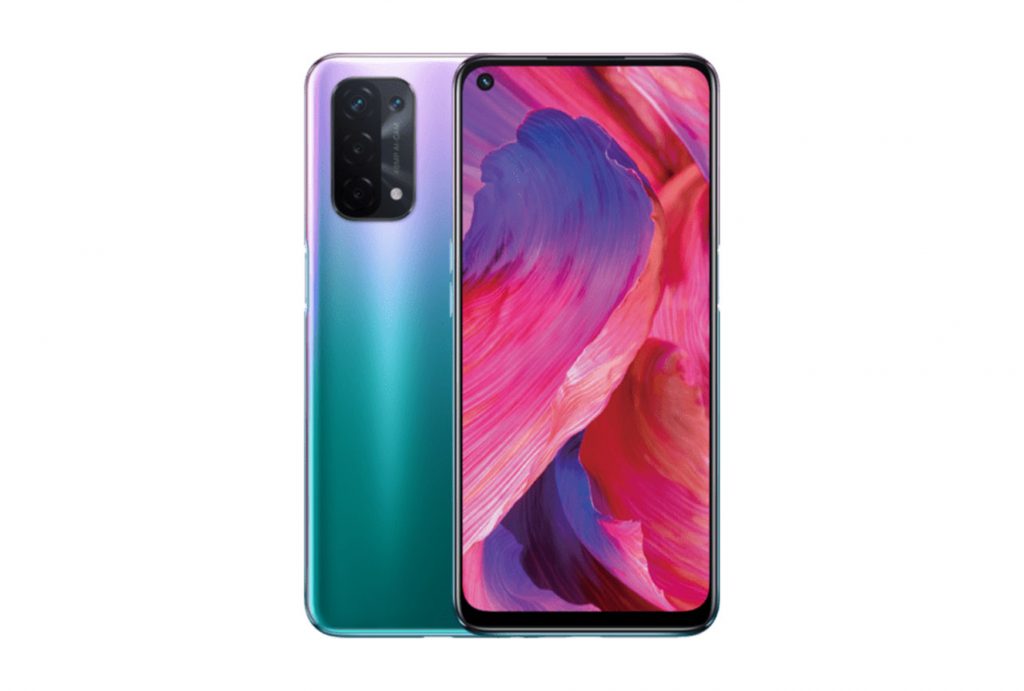Arriving on the market in April 2021, the Oppo A54 5G is the latest addition to our Battery database’s Advanced ($200-$399) segment of smartphones. It comes with a 6.5-inch LCD display, a 48 MP main and 8 MP ultra-wide cameras (along with 2 MP depth-sensing and macro sensors). Our team of Battery experts recently tested the A54 5G, and here is a summary of what they found.
Key specifications:
- Battery capacity: 5000 mAh
- 10W charger included
- 6.5-inch, 1080 x 2400, 90 Hz IPS LCD display
- Qualcomm Snapdragon 480 5G (8 nm) chipset
- RAM + internal storage: 4 GB + 64 GB
About DXOMARK Battery tests: For scoring and analysis in our smartphone battery reviews, DXOMARK engineers perform a variety of objective tests over a week-long period both indoors and outdoors. This article highlights the most important results of our testing. (See our introductory and how we test articles for more details about our smartphone Battery protocol.)
Test summary
Scoring
Sub-scores and attributes included in the calculations of the global score.

Oppo A54 5G


Key performances
These key points are derived from the lab measurements during testing and do not figure into the overall score. The lab measurements, however, are used for the overall score.
 96th
96th
 34th
34th
Pros
- Provides more than 2.5 days (65 hours) of autonomy with moderate use
- Excellent performance for social apps on the go
- Considerably lower consumption than competition for music streaming in 4G
- Very good efficiency score thanks to low discharge current for all use cases
Cons
- Very slow charging, slightly below its competitors
- High consumption for video playback in 4G
The Oppo A54 5G put in a very respectable performance in our comprehensive Battery protocol tests, firmly positioned in the upper half of all devices tested thus far. Although some of its individual scores came in below those of the competitors in this review, its overall performance was quite balanced among all three principal attributes of autonomy, charging, and efficiency. That said, given the A54 5G’s small 10W charger, it is unsurprising that charging is its biggest weakness.
The table below shows the battery capacity; charger; display type, refresh rate, and resolution; and processor specifications for the Oppo A54 5G, the Vivo Y20s from our Essentials (under $200) segment, and the Motorola Moto G9 Power (Advanced segment):
|
Oppo A54 5G |
Vivo Y20s |
Motorola Moto G9 Power |
|
| Battery (mAh) |
5000 |
5000 |
6000 |
| Charger (W) |
10W |
18W |
20W |
| Display type, refresh rate |
IPS LCD, 90 Hz |
IPS LCD, 60 Hz |
IPS LCD, 60 Hz |
| Resolution |
1080 x 2400 |
720 x 1600 |
720 x 1640 |
| Processor |
Qualcomm Snapdragon 480 5G (8 nm) |
Qualcomm Snapdragon 460 (11 nm) |
Qualcomm Snapdragon 662 (11 nm) |
Autonomy (80)
How long a battery charge lasts depends not only on battery capacity, but also other aspects of the phone’s hardware and software. The DXOMARK Battery autonomy score is composed of three performance sub-scores: (1) Stationary, (2) On the go, and (3) Calibrated use cases. Each sub-score comprises the results of a comprehensive range of tests for measuring autonomy in all kinds of real-life scenarios.
Posting an above-average overall score, the Oppo A54 5G is not too far away from the 3-day mark when it comes to autonomy in moderate use. Let’s take a closer look.

Stationary
Oppo A54 5G
84
104
A robot housed in a Faraday cage performs a set of touch-based user actions during what we call our “typical usage scenario” (TUS) — making calls, video streaming, etc. — 4 hours of active use over the course of a 16-hour period, plus 8 hours of “sleep.” The robot repeats this set of actions every day until the device runs out of power.
The Oppo A54 5G provides some 65 hours when it comes to autonomy in moderate use, and it is even closer to the three-day mark in our TUS testing, lasting over 69 hours. While that is some two hours less than the Vivo Y20s, it is more than two hours than the Motorola Moto G9 Power (which has a much larger battery).
Both the A54 5G and the Moto G9 Power consume an average of 2.33% battery level per night, which is much more than the Vivo Y20s’s very good 1%.

On the go
Oppo A54 5G
80
96
Using a smartphone on the go takes a toll on autonomy because of extra “hidden” demands, such as the continuous signaling associated with cellphone network selection, for example. DXOMARK Battery experts take the phone outside and perform a precisely defined set of activities while following the same three-hour travel itinerary for each device.
On the go, the A54 5G battery does well with GPS navigation and social apps — either bettering or coming very close to the competition. That said, it lags a bit behind both the Vivo and Motorola devices for calling.

Calibrated
Oppo A54 5G
75
100
For this series of tests, the smartphone returns to the Faraday cage and our robots repeatedly perform actions linked to one specific use case (such as gaming, video streaming, etc.) at a time. Starting from an 80% charge, all devices are tested until they have expended at least 5% of their battery power.
Back in the cage, the Oppo devices outlasts its competitors in many use cases, ending up with a global score that is quite a bit ahead of the Vivo Y20s’s, though only just two points above Moto G9 Power’s. Looking more closely, the A54 5G is way ahead of both rivals for 4G music streaming; and it is neck-and-neck with the Vivo for 4G video streaming (though the Moto G9 Power outlasts them both). However, when it comes to 3G calling, neither the Oppo nor the Vivo’s duration (under 30 hours) comes close to the Motorola device’s longevity of more than 60 hours (which is the best result for this sub-category across our entire database thus far).
Linearity
When the Oppo A54 5G’s gauge shows 20% remaining, our tests indicate that its true remaining capacity is 17.2%, which is just slightly below that of the Vivo (17.7%) and the Motorola (17.6%) — and among all devices tested thus far, the percentages for these three are just about average.
Charging (55)
The DXOMARK Battery charging score is composed of two sub-scores, Full charge and Quick boost. Full charge tests assess the reliability of the battery power gauge; measure how long it takes to charge a battery from 0% to 80% capacity and from 80% to 100%; and measure how long and how much power the battery takes to go from an indicated 100% to an actual full charge. With the phone at different charge levels (20%, 40%, 60%, 80%), Quick boost tests measure the amount of charge the battery receives after being plugged in for 5 minutes.
Given its small charger, it comes as no surprise that the Oppo A54 5G turns in a poor score for charging. (As per our protocol, we tested it with the 10W charger included in the box, but our engineers point out that the A54 5G could use a 18W charger, which would undoubtedly improve its results.) This said, the size of the charger is not the only factor, as the Motorola device comes with a 20W charger and has a similarly poor 0-80% charging time (even taking into account its larger battery).

Full charge
Oppo A54 5G
54
121
The Oppo A54 5G’s total charging time from 0% to 100% battery capacity is 2 hours 59 minutes, which is 31 minutes slower than Vivo Y20s, but only 6 minutes slower than the Motorola Moto G9 Power. Of this total time, the Oppo takes 1 hour 51 minutes to get to 80%, taking an additional 59 more minutes to arrive at 100% per its gauge. While that is on the long side, it’s worth noting that its gauge is quite accurate, as it takes only 9 more minutes to go from 100% showing to being completely full (99% accuracy).

Quick boost
Oppo A54 5G
59
111
Again attributable to its small charger, the Oppo’s results in our quick boost testing were disappointing but not unexpected: plugging in the A54 5G smartphone for 5 minutes at less than 50% battery level, users will be able to gain 1 hour 50 minutes of autonomy (which is one hour less than the Vivo Y20s, though only ten minutes less than the Motorola Moto G9 Power).
The Oppo takes 1 minute 52 seconds to gain 1% battery level while gaming at low battery, which is only 17 seconds slower than Motorola — again underscoring the fact that a charger’s size is not the only factor involved in charging efficiency.
| Oppo A54 5G | Vivo Y20s | Motorola Moto G9 Power | ||
| Autonomy boost (hh:mm) | 20% | 1:50 | 2:45 | 1:51 |
| 40% | 1:49 | 2:36 | 2:00 | |
| 60% | 1:47 | 2:32 | 2:03 | |
| 80% | 1:45 | 1:45 | 2:06 | |
| Percentage boost | 20% | 3.7 % | 5.5 % | 4 % |
| 40% | 3.7 % | 5.2 % | 4.3 % | |
| 60% | 3.7 % | 5.1 % | 4.4 % | |
| 80% | 3.6 % | 3.5 % | 4.6 % | |
| Energy consumed | 20% | 1012 mWh | 1508 mWh | 1452 mWh |
| 40% | 1004 mWh | 1425 mWh | 1561 mWh | |
| 60% | 992 mWh | 1387 mWh | 1601 mWh | |
| 80% | 971 mWh | 962 mWh | 1641 mWh |
Efficiency (88)
Our Efficiency score comprises two sub-scores, Charge up and Discharge. Charge up is the efficiency of a full charge (how much energy is drained from the wall outlet vs the energy capacity of the battery, as well as the efficiency of the charger and its residual consumption). Discharge is how much current the smartphone drains from the battery when in use (the ratio of battery capacity over autonomy). Better autonomy with a smaller battery means better efficiency.

Charge up
Oppo A54 5G
62
105
At 71.5%, the Oppo A54 5G’s entire charging system (including charge adapter and internal smartphone circuits) is more efficient than the Motorola Moto G9 Power (64.5%) and just a shade ahead of the Vivo Y20s (70.9%).

Discharge
Oppo A54 5G
99
121
The Oppo A54 5G’s discharge efficiency performance is very good compared to many other devices in our database as a whole, and its score of 99 handily beats out both the Vivo Y20s (74) and especially the Motorola Moto G9 Power (50) here. In fact, it does better than both devices in every sub-category, with the exception of 3G calling: in that instance, just as in our on-the-go tests, the Motorola device shows significantly better battery performance than its two rival devices in this comparison.
Conclusion
Oppo A54 5G has a higher Efficiency score than its Vivo and Motorola competitors (and many other devices as well), and a decent score for Autonomy. However, its small charger (and resulting slow charging times across the board) holds it back from achieving a better overall score.





DXOMARK encourages its readers to share comments on the articles. To read or post comments, Disqus cookies are required. Change your Cookies Preferences and read more about our Comment Policy.